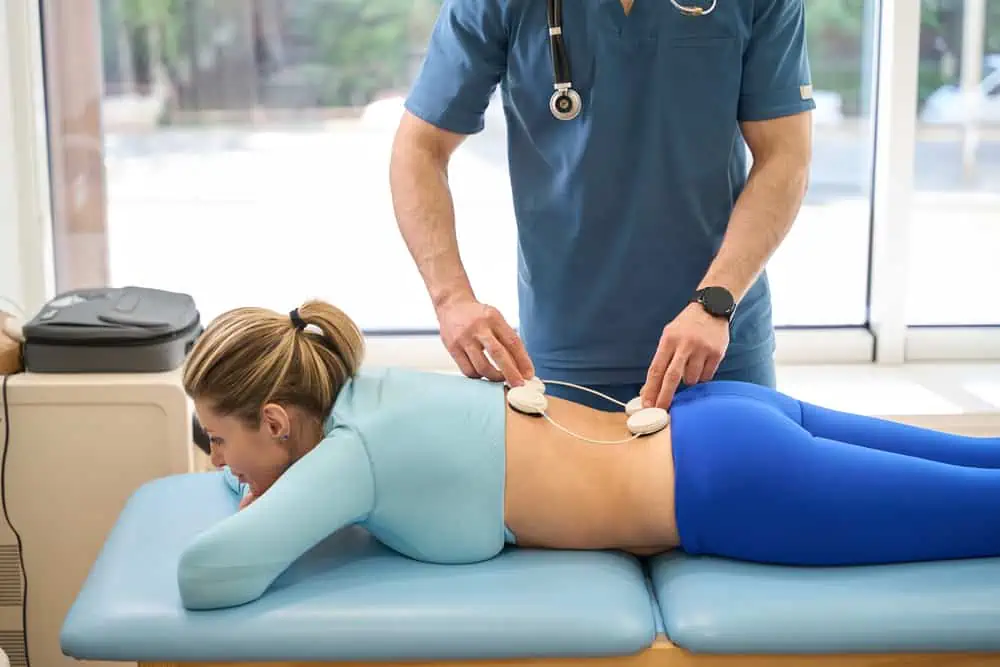Sacroiliac joint pain, often referred to as SI joint pain, is a common condition that affects the SI joint, connecting the pelvis to the lower spine. It can cause discomfort and limited mobility in many individuals. Exercises targeted at this area can provide relief, improve joint function, and enhance overall stability.
We understand the impact that sacroiliac joint pain can have on daily life. That’s why strengthening and stretching the muscles surrounding the pelvis and spine is crucial. By engaging in specific exercises, we can alleviate pain and help prevent future discomfort associated with the SI joint.
Key Takeaways
- Exercises can relieve sacroiliac joint pain and improve mobility.
- SI joint exercises focus on core, lower body, and joint-specific movements.
- Consistency and proper technique are important for effective pain relief.
Understanding Sacroiliac Joint Pain
Sacroiliac joint pain can be a significant cause of lower back pain, often overlooked. This section will help you understand the complexities of the sacroiliac joint, what leads to its dysfunction, how to recognize symptoms, the lifestyle impact, and the importance of seeking professional advice.
Anatomy of the Sacroiliac Joint pain
The sacroiliac joint (SI joint) serves as a critical connector, linking the pelvis to the sacrum, the triangular bone at the base of the spine. Comprising sturdy ligaments and surrounded by robust muscles, this joint supports the weight of the upper body when standing and acts as a shock absorber during physical activity.
Causes of SI Joint Pain
SI joint dysfunction can be provoked by various factors, including pregnancy, childbirth, previous surgery, or injury. Repetitive motion from activities like weight lifting can contribute to wear, as can obesity or acute trauma. Even prolonged sitting or alterations in regular physical activity levels can incite discomfort.
Symptoms and Diagnosis
Common symptoms include lower back pain, pain in the buttocks or hip, and even sensations radiating along the groin area. Diagnosing SI joint pain often involves a physical examination and possibly imaging tests. It’s vital to pinpoint the pain accurately, as the symptoms can mimic other conditions.
The Impact of Lifestyle
Our lifestyle choices, such as the frequency of exercise, types of physical activities, and daily habits like prolonged sitting or swimming, can substantially affect the sacroiliac joint. Aerobic exercise, when done correctly, might support joint health, but it’s crucial to maintain balance with rest and recovery.
Importance of Professional Guidance
Consulting with a physical therapist or other healthcare provider is essential. They offer manual therapy, advice on targeted exercises, and a rehabilitation plan tailored to your needs. Professional guidance ensures that you undertake SI joint pain exercises safely and effectively, with an aim to restore function and reduce pain.
Connecting with the right professionals may require site access or an email inquiry but taking this step can significantly improve the precision of your treatment plan.
Core Exercises for SI Joint Pain Relief

In our pursuit of managing sacroiliac joint pain, targeting the core is indispensable. By enhancing strength in our abdominal muscles, particularly the lower abdominals, and stabilizing the pelvis, we set a solid foundation for reducing discomfort and improving mobility.
Strengthening Core Muscles
Strengthening our core is vital for SI joint stability. Focused exercises that enhance the strength of our lower abdominal muscles and glutes contribute to a stable pelvis, which can alleviate sacroiliac joint pain. We focus on controlled, deliberate movements that engage our core without straining the lower back.
Bridge Exercises
The bridge exercise involves lying on our back with feet flat on the floor and knees bent. By lifting our hips while keeping our feet anchored, we engage the glutes and lower abdominal muscles, forming a straight line from our shoulders to knees. It’s essential to keep our core tight during this exercise to maximize strength and stability around the sacroiliac joint. Progressions might include single leg bridges for added intensity.
Bird Dog Variations
Bird Dog Variations enhance balance and stability in our core. Starting on all fours, we extend one arm and the opposite leg simultaneously, keeping our back flat and our abdominal muscles tight. This variation not only helps to stabilize the sacroiliac joint but also promotes overall core strength and better mobility in our spine.
Supine Pelvic Tilts
Pelvic tilts are excellent for engaging our core muscles and stabilizing the pelvis. While lying on our back with knees bent and feet flat on the ground, we gently tilt our pelvis forward, pressing our lower back into the floor. Holding this pelvic tilt for several seconds before releasing reinforces the lower abdominal muscles and can provide relief for SI joint pain.
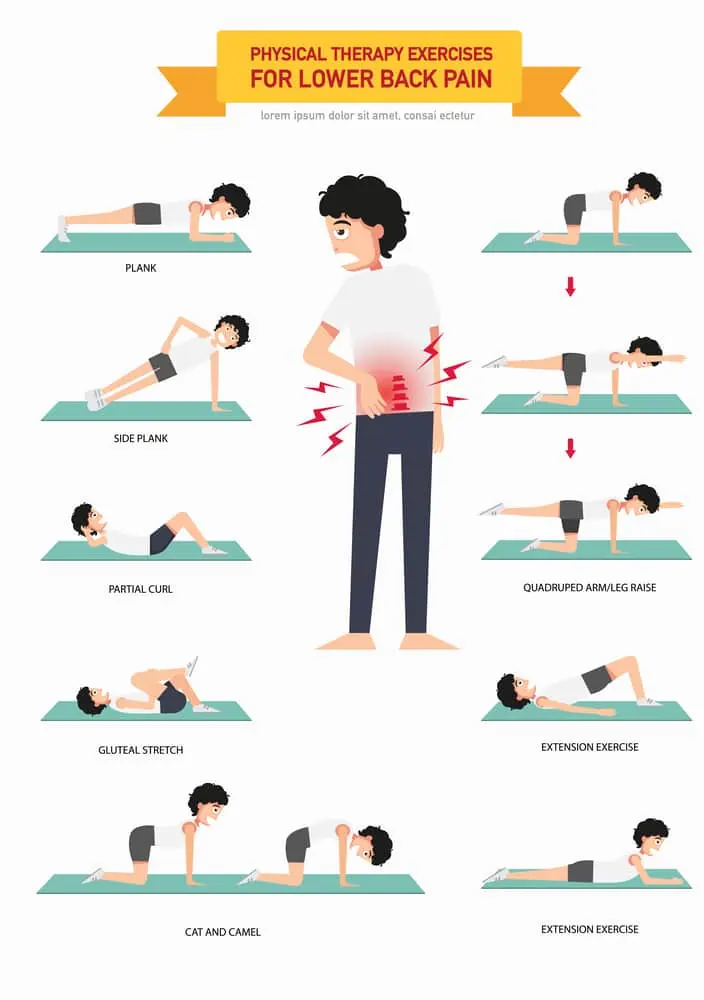
Lower Body Exercises
When addressing sacroiliac joint pain, we focus on enhancing stability and providing relief through targeted lower body exercises. These specifically designed movements aim to fortify the muscles surrounding the hip and sacroiliac joint, promoting a reinforced foundation and thus alleviating discomfort.
Hip and Leg Stretches
For immediate relief from sacroiliac joint pain, stretching is a fundamental approach. Knee-to-chest stretches can alleviate tension in the lower back and hips by gently elongating the muscles. To perform, lie on your back and pull one knee toward your chest, holding the position to feel a stretch in the lower back and thigh muscles. Alternate sides to maintain balanced flexibility.
- Knee-to-Chest Stretch
- Lie flat on your back.
- Bring one knee to the chest and hold.
- Alternate legs and repeat.
Clamshell for Hip Stability
The clamshell exercise supports hip stability, a critical factor for a strong and pain-free sacroiliac joint. This move targets the gluteus muscles and other stabilizers of the buttocks and thigh areas. Lie on your side with legs stacked and knees bent at a 45-degree angle. Open the top knee while keeping feet in contact, like a clamshell opening, then close it. Keep your movements controlled to optimize muscle engagement.
- Clamshell Exercise
- Lie on your side; knees bent, feet together.
- Raise and lower the top knee.
- Perform 10-15 repetitions on each side.
Safe Leg Strengthening
Strengthening exercises for the legs must be gentle on the sacroiliac joint while effectively building muscle in the quadriceps and adductors. Lunges are an ideal choice that promotes leg strength without overexerting the lower back. Ensure proper form to keep the benefits: step forward with one leg, lower the hips until both knees are bent at a 90-degree angle, then push back up.
- Lunge
- Stand straight; step forward into a lunge.
- Lower your body, keeping the front knee above the ankle.
- Repeat for both legs, aiming for 8-10 repetitions each.
Through these exercises, we promote healing and strength in the sacroiliac joint area, addressing both the symptoms and the causes of the pain.
SI Joint Specific Exercises and Stretches
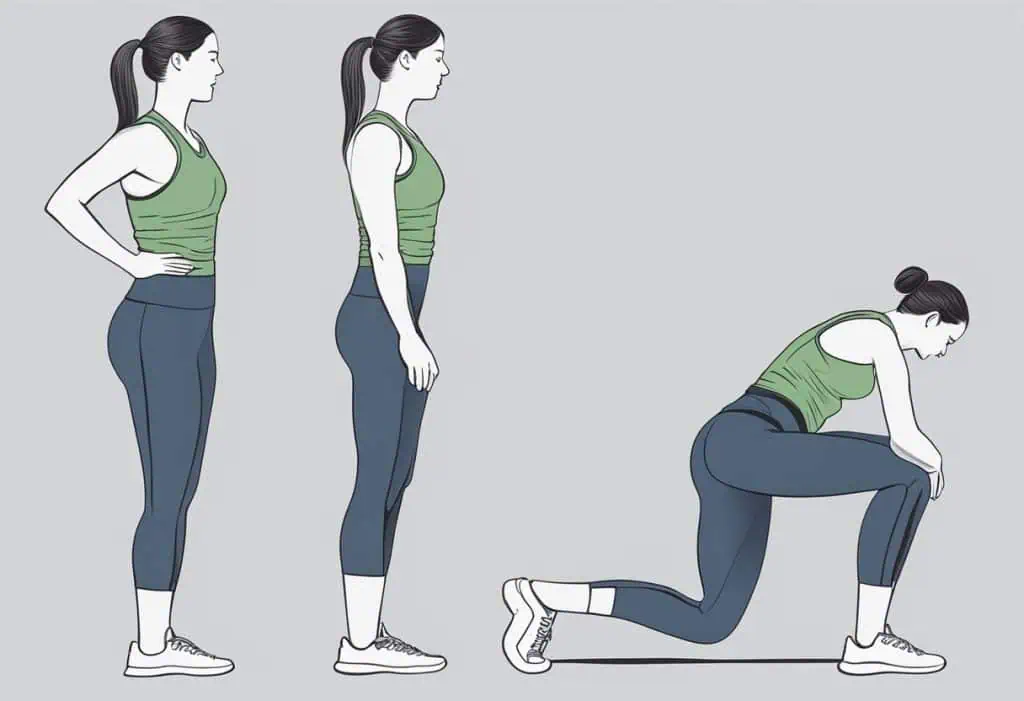
In the following sections, we’ll explore exercise and stretching techniques specifically designed to improve sacroiliac (SI) joint pain, enhance pelvic stability, and promote overall joint function. We must approach these exercises with careful attention to form to ensure safety and effectiveness.
SI Joint Mobilization Techniques
Manual therapy and SI joint mobilization techniques can be vital in restoring normal motion to the joint. Physical therapists often use gentle movements intended to relieve pain and improve mobility. Here are two techniques that can be practiced:
- Distraction Technique:
- Lie on your back with your knees bent and feet flat on the floor.
- Apply gentle pressure hands-on hips, pressing outward to encourage mobility.
- Compression Technique:
- Lie flat and place a medium-sized ball between your knees.
- Squeeze your thighs together, hold for a count of 5, then relax. Aim for 2 sets of 15 reps to help stabilize the pelvis.
Safe Stretching for Alleviating Pain
Stretching can mitigate SI joint pain when done properly. We’ll focus on two stretches that are designed to target the SI joint:
- Knees-to-Chest Stretch:
- This stretch lessens tension in the lower back and hamstrings.
- Lie on your back, bring your knees toward the chest, and hold for up to one minute. Alternate sides for balanced results.
- Child’s Pose:
- A yoga pose that helps in achieving a good stretch on the lower back, promoting balance and function.
- From a kneeling position, sit back on your heels and stretch your arms forward on the floor.
Stabilization and Alignment Activities
To enhance stability and ensure proper alignment of the SI joint, we incorporate activities that promote muscle control and posture:
- Pelvic Tilts:
- Strengthen the abdominal muscles and improve stability.
- Lie on your back, tighten your abs, lift your pelvis, and hold for a count of five.
- Use of Sacroiliac Belt:
- Wearing a sacroiliac belt may provide supplementary stability during activities.
- It can help in maintaining correct alignment and reducing discomfort.
Our choice of si joint exercises should always complement our individual needs, and we should maintain a neutral spine whenever possible to avoid additional strain on the SI joint.
Additional Tips and Considerations
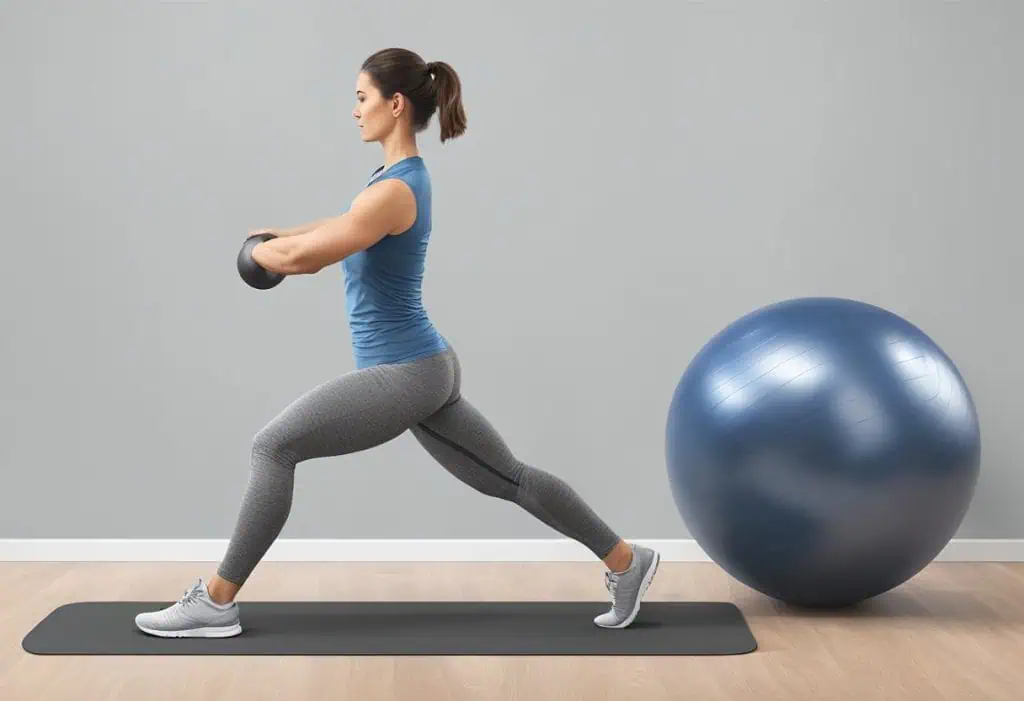
When addressing sacroiliac joint pain through exercise, we not only focus on strengthening and stretching but also on overall wellness and pain management. Aerobic exercise can help increase blood flow, reduce inflammation, and enhance mobility, while specific considerations ensure that exercises are appropriate for various populations, such as pregnant women or older adults.
Incorporating Aerobic Exercise
Aerobic exercises play a crucial role in enhancing flexibility and promoting blood flow, which can lead to reduced inflammation and pain relief. We recommend low-impact activities such as:
- Walking: A gentle and effective way to maintain mobility without straining the sacroiliac joint.
- Swimming: Offers resistance for muscle strengthening while the buoyancy reduces stress on the joints.
- Tennis: A more advanced option, best for those without acute pain, to improve flexibility and muscle control.
Pain Management Strategies
Managing pain is about more than immediate relief; it’s about long-term wellness. Here are two strategies we suggest:
- Heat/Cold Therapy: Apply ice packs to reduce acute inflammation or use heat pads to relax muscles and enhance flexibility.
- Mindful Movement: Incorporate exercises from yoga or Pilates to stabilize the joint and improve range of motion carefully.
Advice for Specific Populations
Men and women’s bodies react differently to exercise, and factors like pregnancy require adjustments to ensure safety and effectiveness. Consider the following:
- Men: Might benefit from focusing on strength in the surrounding muscles to support the sacroiliac joint.
- Women: Should ensure that exercises like pelvic tilts are performed correctly to protect the pelvic floor, especially after childbirth.
- Pregnancy: Low-impact, pregnancy-safe exercises such as prenatal yoga can maintain flexibility and provide pain relief, as long as approved by a healthcare professional.
Conclusion
In managing sacroiliac joint pain, we have discovered that targeted exercises are a cornerstone of effective rehabilitation. Incorporation of such exercises not only aides in pain relief but also provides stabilization for the SI joint.
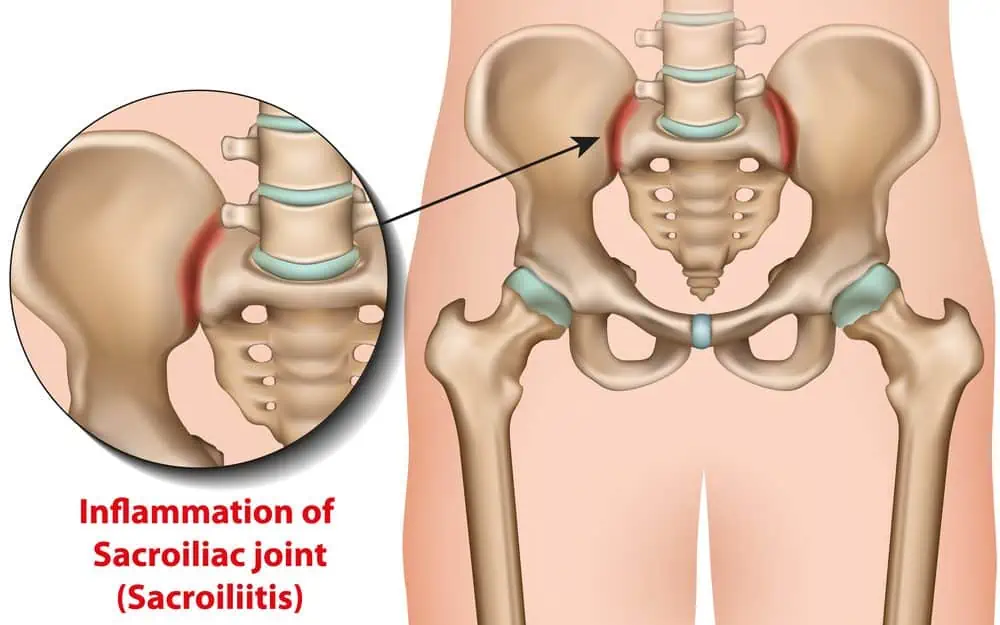
- Engage regularly in approved physical therapy routines.
- Emphasize the importance of proper form to prevent aggravation of SI joint pain.
- Prioritize exercises aimed at strengthening and stabilizing the pelvic area.
It’s worth noting that our body’s response to these exercises may vary, thus patience and consistency are key. It’s advisable to perform these routines under the guidance of a specialized healthcare professional to tailor the program to our individual needs and ensure we’re on the correct path to recovery.
We should also be mindful that while exercise is instrumental in SI joint pain relief, it’s one part of a comprehensive management plan which may include medication, lifestyle adjustments, and other therapeutic options.
Frequently Asked Questions
We understand that finding the right exercises and information can be crucial for managing sacroiliac joint pain. We aim to provide clear and practical advice to help you navigate this discomfort effectively.
What are the most effective exercises for managing sacroiliac joint pain?
The most effective exercises for sacroiliac joint pain typically involve gentle stretching and strengthening of the pelvic, hip, and lower back muscles. For instance, SI joint stretches may include knee-to-chest stretches and piriformis stretches to relieve tension in the pelvis.
Which exercises should be avoided when experiencing sacroiliac joint pain?
It’s important to avoid high-impact activities or exercises that can exacerbate SI joint pain, such as running or heavy weightlifting. Especially, movements that place heavy torsional stress on the pelvis should be avoided.
Can I perform self-managed techniques to relieve my sacroiliac joint pain?
Yes, self-managed techniques like applying ice or heat, using over-the-counter pain medications, and performing SI joint-specific stretches can be effective for pain relief. Gentle strengthening exercises focusing on the core and pelvic muscles can also support the joint.
What sleeping positions are recommended for sacroiliac joint pain relief?
For sacroiliac joint pain relief while sleeping, it’s generally recommended to sleep on your side with a pillow between your knees. This position helps maintain neutral alignment of the hips and spine.
How can I safely incorporate walking into my routine if I have sacroiliac joint pain?
Walking can be safe for SI joint pain if done cautiously. Start with short distances and gradually increase as tolerated. Pay attention to your posture and wear supportive footwear to minimize discomfort during your walk.
Are there any specific NHS-approved exercises for sacroiliac joint pain?
While the NHS provides guidelines on managing lower back pain, it’s best to consult with a healthcare professional to access exercises tailored specifically for sacroiliac joint pain. These professionals can provide exercises that align with NHS guidance and are appropriate for your situation.













